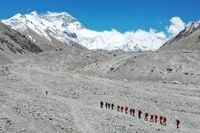As China’s much-anticipated Golden Week holiday unfolded in early October 2025, a dramatic rescue operation played out high on the eastern slopes of Mount Everest, where an unexpected and ferocious snowstorm trapped nearly 1,000 trekkers, climbers, and support staff. The incident, which began on the evening of October 3 and intensified over the next two days, has drawn attention to the growing risks posed by extreme weather in the Himalayas—and the extraordinary efforts of local communities and rescue teams.
According to Chinese state media and multiple international outlets, the blizzard struck the remote Karma Valley, a scenic but less-traveled route leading to Everest’s Kangshung face in Tibet. The area, perched at elevations above 4,900 meters (16,000 feet), had attracted hundreds of adventure-seekers hoping to catch breathtaking views of the world’s tallest peak during China’s eight-day National Day holiday. October is typically a peak season for tourism in the region, with thousands flocking to Everest’s base camps and surrounding trails.
But this year, as Geshuang Chen, a 29-year-old outdoor enthusiast, recounted to the BBC, the weather proved to be anything but typical. Chen’s group of more than 10 experienced hikers set out from Qudang township on October 4, expecting a brief snowfall. “When we woke up the next morning, the snow was already about a metre deep,” she said. Realizing the danger, her team turned back, braving the treacherous conditions. “All of us are experienced hikers. But this blizzard was still extremely difficult to deal with. I was so lucky to get out.”
Others weren’t as fortunate in their escape. The blizzard’s suddenness left campsites buried under heavy snow, with tents collapsing and hypothermia becoming a real threat. Eric Wen, another survivor, told Reuters that three members of his group suffered from hypothermia despite being adequately dressed. “It was snowing too hard,” Wen said. “We had to clear the snow every 10 minutes. Otherwise, our tents would have collapsed.” He added, “We only had a few tents. More than 10 of us were in the large tent and hardly slept.”
Rescue efforts began swiftly, with hundreds of local villagers and organized rescue teams deployed to clear snow and guide stranded trekkers down the mountain. By October 5, rescuers had successfully led 350 people to safety in the small township of Qudang, according to China Central Television (CCTV). Contact had also been made with more than 200 others still on the slopes, who were being guided down in stages. The operation was far from simple—thick snow blocked access routes, and even rescuers struggled to forge a path. As one woman from Shenzhen told the BBC, her husband, who was among those trapped, was “slowly retreating from the mountains,” facing daunting conditions. “Even for rescuers, it’s not easy, they need to clear snow to make a path,” she said. “I hope my husband’s team reaches [the rescue team] safely.”
Survivors described a harrowing ordeal marked by thunder, lightning, and relentless cold. Upon reaching Qudang, they were greeted by villagers offering warmth, food, and sweet tea—a moment of relief after a night of fear and exhaustion. “Back in the village, we had a meal and were finally warm,” Chen told Reuters, her voice filled with emotion. The sense of community and support was palpable, even as the scale of the disaster became clear.
Authorities responded by suspending ticket sales and entry to the Everest Scenic Area from late Saturday, aiming to facilitate rescue operations and prevent further risk to tourists. Notices posted on official WeChat accounts made it clear: the region would remain closed until conditions improved. The local government of Shigatse, which encompasses the Chinese side of Everest, assured the public that stranded hikers had sufficient supplies, though the duration of their ordeal remained uncertain.
The storm’s impact extended far beyond Everest itself. Neighboring Nepal, already vulnerable to extreme weather, suffered deadly landslides and flash floods triggered by heavy rains since October 3. At least 47 people were killed, dozens more were missing, and major roads and bridges were washed away, according to reports cited by Reuters and Sky News. Meanwhile, on China’s eastern coast, Typhoon Matmo made landfall, forcing 150,000 people to evacuate their homes—an unsettling reminder of the region’s climate vulnerabilities.
For those on the mountain, the experience was a sobering lesson in the unpredictability of nature. “The weather this year is not normal,” Chen Geshuang told Reuters. “The guide said he had never encountered such weather in October. And it happened all too suddenly.” Her words echoed the sentiment of many who had come to Everest seeking adventure, only to find themselves at the mercy of forces beyond their control. The snowstorm, described by local media as the heaviest in recent years during the National Day holiday, buried tents and left even seasoned guides astonished.
Despite the ordeal, the rescue mission was widely praised for its speed and effectiveness. Hundreds of villagers and professionals worked around the clock, clearing paths and bringing down those still stranded. Footage obtained by Reuters showed lines of hikers trekking through snow with poor visibility, while others huddled in tents with ropes buried under the accumulating drifts. The sense of urgency was matched by a spirit of resilience and cooperation—qualities that, time and again, prove vital in the face of disaster.
Mount Everest, at 8,849 meters (29,000 feet), has long been a magnet for adventurers and tourists alike. In recent years, Chinese investment in the region’s tourism infrastructure has seen visitor numbers soar, with more than 540,000 people visiting the area in the previous year alone, according to state media. Yet the storm underscored the dangers that come with popularity, as overcrowding, environmental concerns, and now extreme weather events add new layers of complexity to managing the world’s highest peak.
As the dust—or rather, the snow—settles, questions linger about emergency preparedness, the impact of climate change on Himalayan weather patterns, and the balance between adventure tourism and safety. For now, the focus remains on guiding the remaining trekkers to safety and restoring access to the region. But for those who lived through the blizzard, the memory of that night on Everest will not soon fade.
One thing is certain: nature’s power remains humbling, and in the mountains, even the best-laid plans can be upended in an instant.






